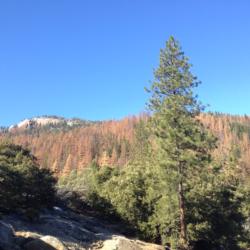Tree Mortality
Tree mortality resulting from the drought of 2012 to 2016 was unprecedented. Here is a recent summary from the Tree Mortality Data Network in California Agriculture gives an overview of the size and effects of the mass tree mortality event. This video by CalEco explaining the details is also great: Ponderosa Pine Mortality, the Western Pine Beetle and Drought.
Trees died throughout the state but especially in the southern Sierra Nevada. Trees weakened by drought could not defend themselves from beetles, who burrowed under the bark and laid eggs. The larvae hatched and their burrow killed and girdled the trees. Other trees died directly as a result to drought.
University of California and other researchers have been collaborating to measure tree mortality in the Sierra Nevada and identify the causes and future trajectory of affected stands. For information including data summaries and events, please click on the Tree Mortality Data Collection Network page.
Bark beetles have had massive outbreaks throughout western North America in recent years. More information on the causes, control, and consequences of bark beetle outbreaks can be found in this August 2017 webinar by Dr. Jodi Axelson, UC Cooperative Extension forest health specialist.

Keeping Trees Healthy
Keeping trees healthy so they can fight off bark beetle attack is the best way to help them. Bark Beetles of California
Plant a variety of species adapted to site: In general, native species will withstand the extremes of climate better. Also, many insects attack only a specific tree. Therefore, having a variety of trees means they won't all be attacked at the same time.
Thin / promote healthiest individuals: Many Sierra forests are overstocked after 100 years of fire suppression. Thinning out a forest allows more sun and water for the remaining trees, which will be healthier and better able to repel insect attacks.
Water: Watering trees helps them fight off beetle attacks. Usually this is only feasible for high value trees near the home that can be reached by watering systems. Use of Greywater in Urban Landscapes in California
Chemical treatments: Several pesticides have been shown to be effective at preventing western pine beetle infestation. Carbaryl provides two years of protection and pyrethroids provides one year of protection. They must be applied by licensed pesticide applicators before the trees are attacked. Using Insecticide to Protect Conifers from BarkBeetle Attack
Diagnosing tree attacks
Identify the species of insect attacking a tree:
1) Identify the species of tree (some trees have few or only one species that attack them)
2) Determine the location of insect attack on the stem. For example on large pines, engraver beetles attack near the top, red turpentine beetles attack the bottom of the trunk and others attack the middle of the stem.
3) Identify the pattern of galleries under bark which is individual to each bark beetle species
Dealing with dead trees
Dead trees pose both a safety and fire hazard depending on where they are. Dead and dying trees near a home or important infrastructure should be removed quickly. This is often a costly and difficult thing to do.
Most beetles, including the western pine beetle, feed only on live trees. Therefore they have usually left the tree before it appears completely dead. However, pine engraver beetles, which kills trees from the top down, can breed in dead or dying trees for up to 5 weeks after they have been felled. Therefore its important to avoid letting slash or green logs accumulate near living trees. Instead, logging debris should be: chipped, cut into smaller pieces (> 4“ in diameter and 3' long) and scattered (lop and scatter), piled and burned, crushed and mashed into the soil, removed from site, or wrapped in clear plastic for up to 5 weeks. Controlling Bark Beetles in Wood Residue and Firewood
Bark beetle resources
UC Resources:
- UC Forest Stewardship Series: Pests and Disease
- UC Master Gardeners - find a local program
CalFire Ready for Bark Beetle website
California Forest Pest Council
Pest ID websites:
